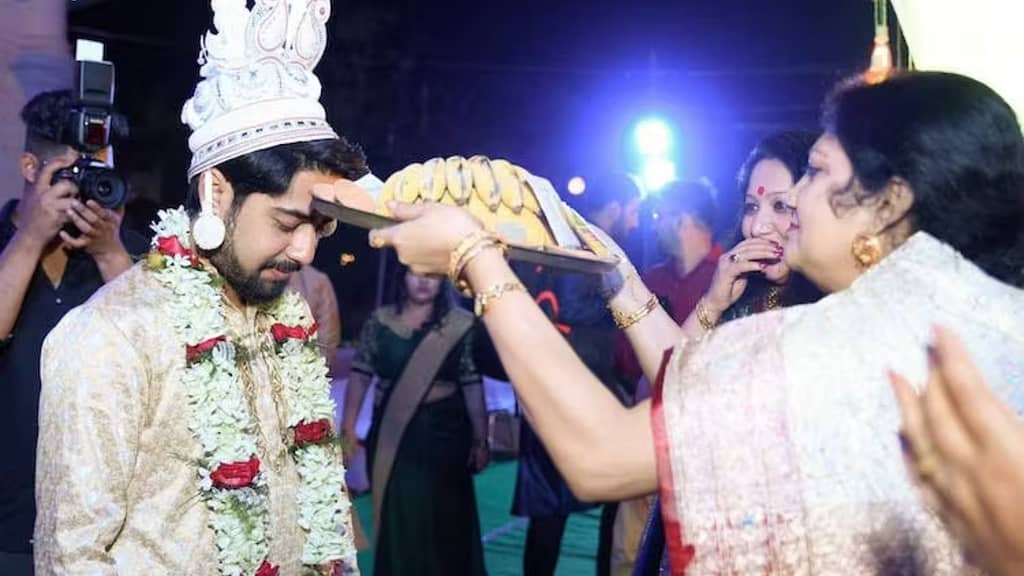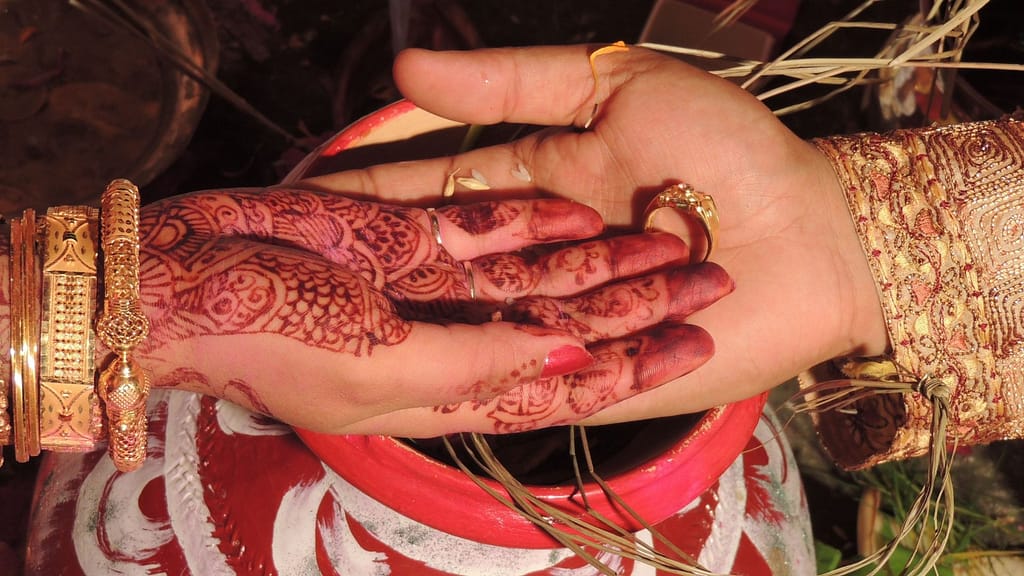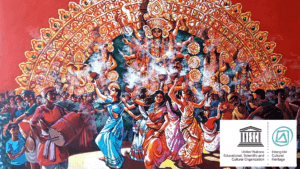If you think that you have come across all the splendor and glitters at the weddings you have attended to date and you have had enough entertainment and frowning moments, I request you to hang on. We have something very special, colorful, as well as ritualistic wedding experiences to share with you. Have you guessed what I am talking about? It is nothing but the Wedding Ceremony of Bengalis in Kolkata, West Bengal. Bengali weddings and their rituals are a treat to the eyes. Along with gladsome parts of the Bengali marriage ceremony, Bengali weddings are renowned for their spectacular traditional customs and rituals.
More or less, it is a ceremony celebrated for four to five days in general. However, if anyone counts the rituals from Ashirbaad to Astamangala (Somewhere it is Dashamangala); the ceremony takes up to 10 days to get completed with thorough rituals and customs as well. The best part of Bengali wedding rituals is that these rituals never make feel you bored or dull. So, fasten your seat belt and get ready to explore highly traditional yet sweet right from your all-time favorite online podium – Curious Kasturi, the best place to gain knowledge on traditions, astrology, Vastu, and more.
Bengali Wedding Rituals – at a Glance
All the Bengali rituals for marriage are divided into three parts. These are
- Pre-Wedding Rituals,
- Wedding Rituals,
- Post-Wedding Rituals.
If you want to learn about every ritual, please keep reading this blog. We can guarantee, you will feel amazed and filled up with joy decoding the picturesque beauty of rituals in Bengali weddings.
Bengali Wedding Ceremony Rituals in Detail
To make the learning expedition easy for you all, we discuss the rituals in different parts following the sequences included in Pre-Wedding Rituals, Wedding, and Post-Wedding Rituals. Let us begin….
Pre-Wedding Bengali Rituals
Ashirvad: One of the precious moments every Bengali Bride and Groom undergoes. This is actually the engagement ceremony in Bengali tradition. The ceremony is arranged 2 to 3 days before of marriage day. However, in some families, this engagement ceremony gets organized a few months before the wedding. With close relatives and friends, the groom’s family visits the bride’s place and showers her with blessings. The bride also receives so many gifts from the groom’s side. You can call the day, Ashirvad Day as an official date of alliance and acceptance of new members between two families.

Aai Budo Bhaat: This is the ritual of having the last meal as a bachelor for both bride and groom. This ceremony is arranged in both houses of the bride and groom, and an array of delicious dishes are prepared by friends, relatives, and family in honor of would-be bride and groom.

Wedding Day Bengali Rituals
Dodhi Mangal:The very first ritual performed early morning (Dawn) in the houses of the bride and groom. Brides generally wear red-bordered white saree and grooms wear dhoti-kurta. Both are served Dahi (Sweet Yoghurt) and Khoi (Puffed Rice) as a pious meal before they enter into a new life.

Ganga Nimontron: In this ritual, Maa Ganga (Holy River Ganges) is invited by the Mother of the bride and other married women with a brass pot or Kalshi. The mother or any senior married woman fills the pot with water during the invitation and comes back home with the water-filled pot.

Vridhi: One of the most important Bengali marriage rituals performed by seniors, especially the fathers of the groom and bride at the Bengali wedding venue. This is a kind of puja performed to worship ancestors and to observe their blessings. The participation of the Bride and groom at this puja is mandatory.

Gaye Halud: Bengalis know how to look beautiful and glowing on the day of their wedding with natural elements. We use the Wonder Spice filled with anti-oxidant – Turmeric (Holud) to accomplish the Gaye Holud ritual. First, the bowl of turmeric paste is prepared in the groom’s house. The groom touches the paste and then the bowl is sent to the bride’s house for the ritual to be accomplished. The paste is applied to the bride before she takes a bath. It is a fun moment as everyone applies the turmeric on each other after the ritual and shares glee moments.

Sankha Pola Ceremony: The priest or any elder male member of the bride’s family puts the Sankha Pola on the bride’s hands. Ad interim, the priest chants the pious mantra and performs a puja in the name of the bride for her long life and overall health. The ritual is performed in the presence of Seven married women in some houses.

Bor Boron: As soon as the groom gets ready for the wedding with traditional attire, jewelry, and beautiful makeup, she reaches her wedding venue. The joy and glory of the evening start echoing with the wedding vibes right with the moment. While the groom enters (dressed in traditional Bengali wedding attire – Dhuti, Panjabi, and Topor) the venue with his family and friends, the bride’s mother welcomes him with aarti and does his Misti-Mukh with sweets and water. It is a part of the Bengali wedding ceremony ritual you know.

Saat Paak: Saat Paak is one of the most gracious rituals in Bengali weddings. The bride is taken to the Mandaap on a wooden stool carried by her four brothers. The bride moves around the groom seven times sitting on the wooden stool held by her brothers.
Shubho Drishti: Right after the Saat Paak, the bride and groom look at each other. The bride opens her face moving the betal leaves away and looks at her groom with a bit of shyness and a smile. This is called Shubho Drishi.

Mala Bodol: One of the best moments in Bengali weddings is the MALA BODOL. The bride and the groom exchange their floral garlands 3-times with each other. To add an extra punch of fun and excitement, the bride’s brother uplifts her a bit higher to make the garland exchange a bit tougher for the groom. The groom’s relatives also do the same to have frolicking.

Sampradaan: Next, both the bride and groom sit in front of the priest together to perform other rituals. The father of the bride gives her daughter’s hand to the hand of the groom, and the priest ties both hands with a sacred thread and places the hands on the Mangal Ghat. The priest continues to chant the wedding mantras and both the bride and groom chant the same following him. This ritual is called the Sampradaan.

Yagna: Following the wedding rituals in Bengalis, a sacred Yagna takes place in the mandap to worship the Sacred Fire or Agni Deva. The priest chants the Vedic Wedding Mantras to invite Agni Deva and be the witness of the sacred union of two souls for their whole life.

Saptapadi: This ritual is similar to Saat Phera performed at different weddings of different communities in India. This is one of the most auspicious wedding ceremony rituals in Bengali and it is known as Saptapadi. The couple takes seven rounds around the sacred fire stepping on seven betel leaves arranged on the ground. In some weddings, the brothers and sisters of the bride and groom move with the bride and groom holding diyas and other auspicious elements. However, the importance of the ritual remains the same.

Anjali (Khoi Daan): Next, the bride and groom both offer a tray of puffed rice to the holy fire, Yagna Kunda. The brother of the bride offers the puffed rice to the hands of the bride to complete the offering. The groom holds the hand of the bride during the ritual from behind to complete the ritual.

Sindoor Daan: The final ritual of the wedding day is the Sindoor Daan Anusthan. It is a holy mesmerising moment. The groom smears a pinch of Vermilion or Sindoor on the middle hair parting of the bride starting from the forehead. Just after the sindoor daan, the bride’s face is covered by a new saree presented from the groom’s side. The saree is called Lajjya-Bastrya

Post-Wedding Bengali Rituals
Bashor Ghor: With the final ceremony of the wedding day, the bride and groom are shifted to a room filled with friends and younger family members like brothers-in-law, sisters-in-law, and cousins. This room is called Bashor ghor and it is kept well decorated. The bride and groom here sit together and spend a heart-full moment with all for the whole night and other performs singing, dancing, poetry, and other amusing things to enjoy.

Bashi Biye: The next day after the wedding Bashi Biye is one of the traditional Bengali wedding rituals performed by all Bengali families. On this day, the bride and groom take part in various rituals again and the groom smears sindoor on the bride’s forehead again. In some Bengali families, the Saptapadi ritual is performed again under the presence of a priest.

Bidai: In the evening of the Bashi Biye, the bride and groom take blessings from the elderly members of the family and the bride leaves her father’s house to start a new journey of her life. She sets off on the way to her new home – Sosur Bari with her groom.

Bou Boron: Next, the bride reaches her new home and gets welcomed by her mother-in-law. She enters the house after an aarti by placing her feet into a flat container filled with milk and alta (Lac Dye). Next, she enters her groom’s home (Sosur Bari) with stained feet walking in a white saree.

Kaal Ratri: This is the first night after the wedding day and it is called Kaal Ratri. The bride and groom spend the night separately and are not allowed to see each other to avoid bad omen.
Bhat Kapor Ceremony: The very next day in the groom’s house, a ceremony is arranged which is called Bhat Kapor. The groom hands a platter of food with saree and ornaments to his new wife and promises to take care of all her needs throughout her life.

Bou Bhat (Reception): The second last ceremony of a Bengali marriage ceremony. The groom’s family arranges a party in honor of the bride. Friends and families are invited here to bless the newlywed couple. The event ends with grand wedding dining.

Last but not least….
Just after the Bou Bhat, there is a ritual called Phool Sajya (24). Bride and Groom spend their first night of love together in a beautifully floral decorated room and start their new life with glee and happiness. Then comes the ritual of Dira Gaman (25) which is also known as Ashta Mangala or Dasha Mangala. In this Bengali marriage ritual, the bride and groom come to the bride’s home and untie the knot in the presence of a priest they tie on the wedding day before Saptapadi.
Hope, you enjoyed reading the blog. And if you like to read about other wedding rituals on our platform then feel free to let us know. We love to hear from you.



